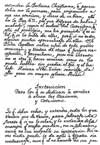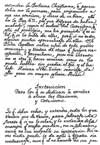http://www.jrebelde.cu/2006/abril_junio/junio-7/cuba_manuscritos.html
A two-hundred-year-old manuscript
By
publishing a catechism designed to Christianize African-born slaves, at the
time an instrument of submission and exploitation, the National Library
‘José Martí’ celebrates Librarian’s Day.
Luis
Hernández Serrano
cult@jrebelde.cip.cu
A text written over two centuries ago to teach Christian Faith among slaves
is the second title Ediciones Bachiller released today in honor of
Librarian’s Day, which happens to be also the birthday of Antonio Bachiller
y Morales, Cuban Library Science’s founding father.
 Eliades
Acosta Matos.
Eliades
Acosta Matos.
Foto: Franklin Reyes
National Library director Eliades Acosta Matos says it is a facsímile reproduction of Explicación de la doctrina cristiana acomodada a la capacidad de los negros bozales (An explanation of Christian doctrine adapted to the abilities of unlearned Blacks), written by the Cuban priest Antonio Nicolás Duque de Estrada and published in 1797, the original manuscript being kept at that Library.
The first title issued by Ediciones… and launched at the past Book Fair was a second edition of Cómo surgió la cultura nacional,(How national culture developed), a text published in 1961 by researcher Walterio Carbonell, who is still employed in the Library.
“These editions will come out in four collections: ‘Arca’, for assorted materials and manuscripts yet unpublished or hard to find; ‘Anaquel’, for texts about Library Science and its multiple fields; ‘Folium’, a selection of a juicy stock of brochures detailing facts of several centuries of existence and cultural interbreeding, and ‘Escribanía’, for strictly historical subjects, as in the case of this Catechism.”
Handwritten by the author, the document includes the following note: “If I die intestate, may this little notebook be given to the Honorable Bishop of this diocese”.
“It’s very important that we reproduce it since it has not circulated as a text in Cuba except among the few researchers who have been able to consult it here in our center, and so much so in the 120th anniversary of the end of slavery in Cuba.”
One of such
scholars is Tato Quiñones, the Cuban writer and researcher who wrote the
foreword. There is much food for thought in this text about the meaning of
slavery in Cuba and the need to strengthen people’s anti-racism,
anti-dominance and anti-hegemonism consciousness.
Eliades says that the text has the additional advantage of being a facsimile and therefore showing the epoch’s original handwriting and idiomatic turns of phrase, as well as what the author wanted to emphasize, and where he wanted to get a reader’s attention.
The document is further enhanced by a text provided by Alicia López Ramos, a specialist from our Library’s Manuscript Section who studied the Literature and Linguistics Institute.
It was printed twice before. Of the first print run there are no copies left in Cuba, and only this copy of the second one, which was made in Boloña Printing Office in Havana and is now kept in the said Institute.
This notebook resulted from a Cuban priest’s attempt at tailoring catechism, or Christian doctrine, to those slaves shipped to our country who were yet to learn Spanish or spoke it very badly, as if they were wearing a dog’s bozal (muzzle) over their mouths, hence their nickname bozales.
They were Africans just put ashore from slave ships who were trying to understand where they had landed or been taken to by force and what was expected of them.
“Although Father Duke of Estrada speaks cautiously in his Catechism, that is, without openly denigrating the slaves, it must be remarked that what he’s preaching under a veil of Christian sermons is a doctrine based upon the slave’s outright submission. It’s merely a way to eliminate and disrupt any rebelliousness, to subdue and make them resign themselves to their fate, and to keep them from rising up against their masters and foremen.”
---ooOoo---
